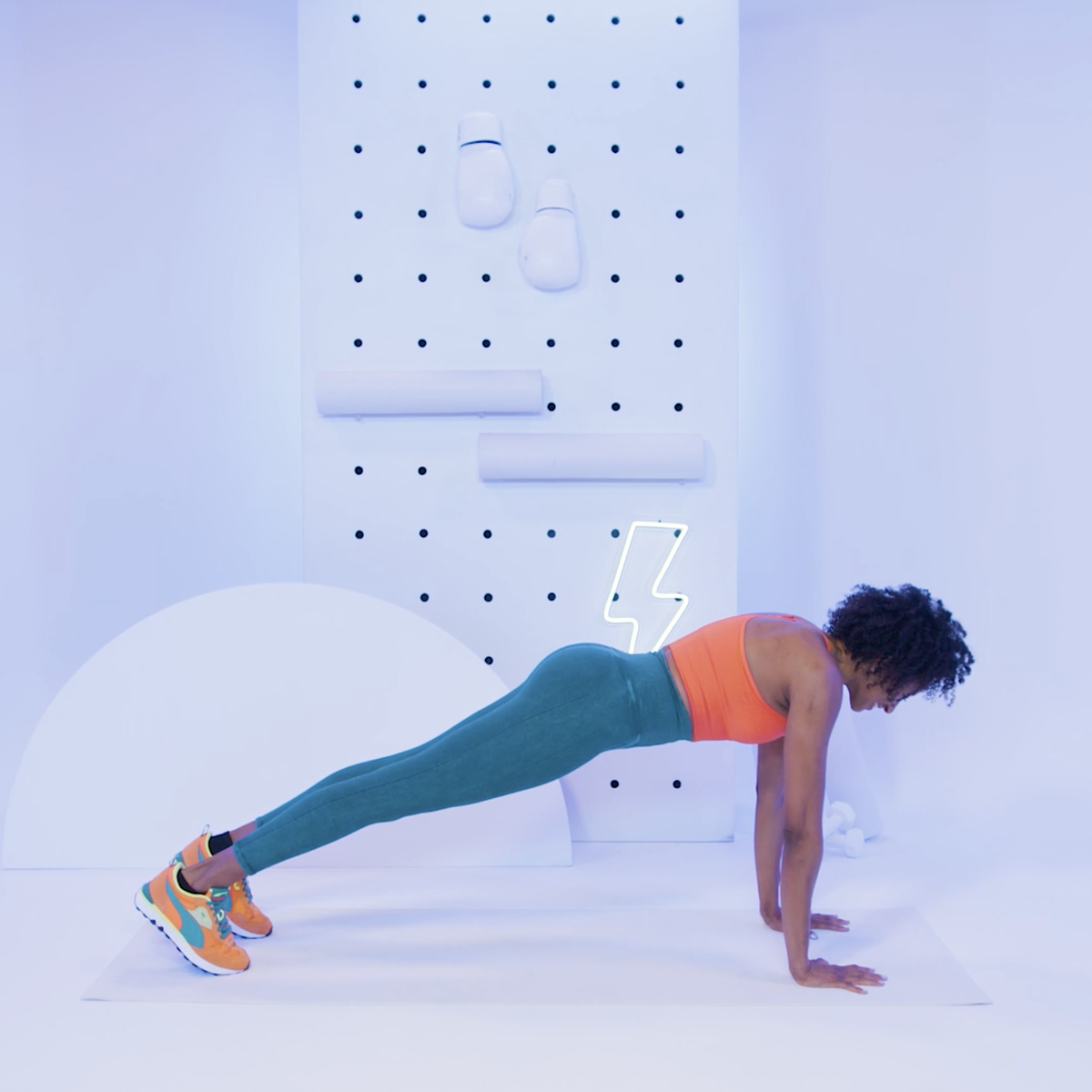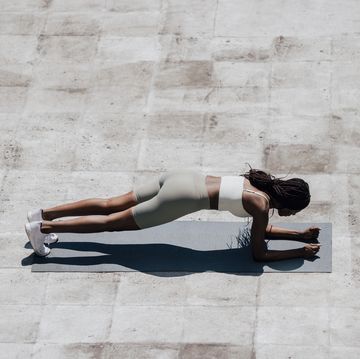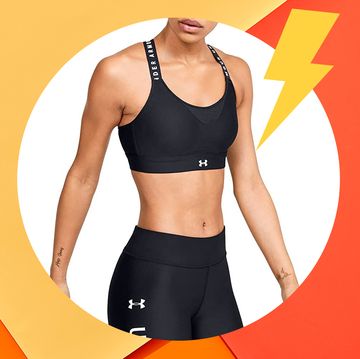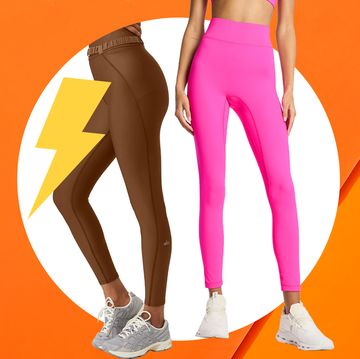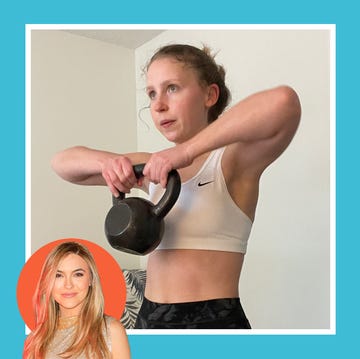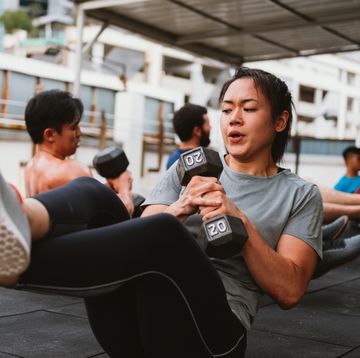I used to roll my eyes at any pre-workout stretch. Little did I know, skipping those moves was holding me back. Dynamic stretching before a sweat sesh is key for optimizing performance, reducing the risk of injury, and preparing muscles for maximum efficiency.
“Dynamic stretching is an active form of stretching where your muscles and joints move through your full range of motion,” says Jessica Chellsen, DPT, CSCS, physical therapist and founder of Vibrant Coast Physical Therapy & Wellness. “It incorporates whole body movements rather than just one muscle group and uses similar movement patterns as the sport or workout you are going to perform,” she explains.
Meet the experts:
Jessica Chellsen, DPT, CSCS, is a doctor of physical therapy, certified strength and conditioning specialist, and founder of Vibrant Coast Physical Therapy & Wellness.
Kendall Green, DPT, CSCS, is a doctor of physical therapy and certified strength and conditioning specialist at Myodetox.
Joseph Bryan Lipana, DPT, CSCS, is a doctor of physical therapy, certified strength and conditioning specialist, and owner of FYZICAL Punta Gorda.
More From Women's Health

Basically, performing dynamic stretches before a workout sets you up for success. They elevate your heart rate and warm your muscles in preparation for the activity, which is crucial for injury prevention, Chellsen adds.
Another bonus? Dynamic stretching is an excellent way to break up the workday. “If we spend many hours in a fixed position, like when sitting at a computer or driving to work, we may become prone to staying in that fixed position and lose the ability to move through the entire range of motion,” says Kendall Green, DPT, CSCS, a physical therapist at Myodetox. “Taking micro breaks and performing dynamic movements every 12 hours after being in a fixed position will help prevent this.”
Ready to loosen up and reach your full fitness potential? Keep scrolling for everything to know about the benefits of dynamic stretching and dynamic stretching routines for warming up, running, and when sitting at a desk all day.
Dynamic Vs. Static Stretching
You’ve likely done both types of stretching and may not even realize it. Static stretching is when you hold a muscle in its lengthened position for a sustained amount of time to stretch muscles and tendons, says Joseph Bryan Lipana, DPT, CSCS, a physical therapist and owner of FYZICAL Punta Gorda. While the purpose of static stretching is to decrease muscle stiffness, when this occurs, it can temporarily decrease the power and force ability of the muscle, adds Chellsen.
In fact, static stretching has been found to reduce your maximum voluntary muscle strength and power, which is why most trainers program dynamic stretching prior to an athletic activity, adds Chellsen.
Remember that, during dynamic movements, muscles are working to create and control movement in both shortened and lengthened positions, explains Green. This means dynamic stretches are best for before a workout since they help to warm up the muscles and stimulate activation.
In contrast, static stretching only involves elongation of muscle fibers and is most successful when the muscle being lengthened is relaxed, she adds. As a result, opt for static stretching after a workout since they help to cool down your muscles and promote relaxation.
When To Use Dynamic Stretching
Dynamic stretching is best used before any activity (think: running, playing tennis, golf, pickleball, or HIIT workouts) to improve performance and prevent injuries, says Lipana. “It’s especially important to perform dynamic stretches before activities or sports with a higher risk of injury (think CrossFit, heavy lifting, or sprinting),” he adds.
Adding in dynamic stretches before weightlifting is also a good idea, says Chellsen. “When weight lifting, your goal is to increase your strength and power through your functional range of motion, and dynamic stretching allows you to prepare for this as well as warm your body up to reduce the risk of injury.”
You can also sprinkle it into your workday, too. Dynamic stretching is a great “it’s the middle of the workday and I’ve been sitting for hours” activity, notes Green. This will help stimulate blood flow, activate your muscles, and promote muscular coordination, adds Lipana.
Benefits Of Dynamic Stretching
- Increase range of motion. “With dynamic stretching you are contracting your muscles through the full range of motion that you will be using in your activity rather than just a static hold,” says Chellsen. This means you’re promoting the joint's range of motion and decreasing passive stiffness of the muscles.
- Decrease risk of injury. By increasing the elasticity of your muscles (the range you can stretch them) you’re reducing your risk of injury during activity, says Green. Plus, since dynamic stretching reduces passive stiffness of your muscles and increases joint mobility, you’ll be primed for training, adds Lipana.
- Prep your brain for movement. Dynamic stretching sends signals to the brain that your muscles are ready to go, alerting the neurological system to promote faster and stronger muscles, says Green. This is especially great for sport specific movements like running, jumping, or dancing, since you’ll warm up the designated muscles you need to use and “prime your brain” for that specific movement pattern, adds Chellsen.
- Promote blood flow. Dynamic stretching is a fabulous way to bring increased blood and oxygen to your muscles, says Chellsen. “It also increases your core body temperature, which helps prepare your body for exercise,” she adds. As a result of the increased blood flow and heightened body temperature, dynamic stretching also warms the muscle tissues, helping to activate the muscle’s elastic properties for more mobility in the joint, adds Green.
- Improve performance. Whether you want to nail a HIIT workout or crush a Pilates sweat sesh, dynamic stretching improves your sport performance, says Green. “This is due to an increase in the rate of force development and muscle fiber recruitment, so the muscles will turn on faster and will be more activated than without a warmup,” she adds.
- Optimize joint health. Healthy joints are the key to a healthy life, and dynamic stretching is a surefire way to protect and support your joints, says Green. “When we move, there is an increase in synovial fluid which essentially lubricates the joint capsule,” she explains. “The motion is the lotion!”
Best Dynamic Stretches For Warming Up
1. Jumping Jacks
Why it rocks: Jumping jacks are a great warm-up for any type of movement because they work your shoulders, adductors and abductors (inner and outer thigh), calves and glutes, says Lipana. You’ll also fire up your heart rate and neurological system which will set you up for a killer workout.
How to:
- Start standing with feet together and arms at sides.
- Then, simultaneously raise arms out and overhead while jumping feet out past shoulders.
- Without pausing, quickly reverse the movement. (Stay on balls of feet throughout movement.) That's 1 rep.
2. Inchworm
Why it rocks: This exercise dynamically stretches your hamstrings while also warming up your core, shoulders, and chest, says Chellsen. You can also expect a little core and oblique workout as you shift your weight back and forth between your hands.
How to:
- Start standing at the back of the mat with feet hip-width apart and arms by sides.
- Slowly bend over and touch the floor in front of your feet with both hands. Keeping legs as straight as possible and core tight, walk hands forward into a plank position.
- Pause, then slowly reverse the movement to return to start. That's 1 rep.
3. TWY
Why it rocks: The TWY stretch opens up muscles on the front of the body including the pecs and the biceps, while activating muscles on the back of the shoulder blades and spine, says Green.
How to:
- Start standing with feet hip-width apart, and hinge at the hips to bring torso slightly forward while maintaining a straight back.
- Extend arms out to sides to form a T shape.
- Maintaining body position, swing arms up so the upper arms align with the ears, forming a Y shape.
- Core engaged the entire time, bend elbows to waist and retract the shoulder blades to form a W shape. That’s 1 rep.
4. Hip Openers
Why it rocks: Hip openers are an excellent move for warming up your core and your hips, as well as preparing your body for any single leg movements, says Chellsen.
How to:
- Start standing with feet shoulder-width apart and elbows bent at a 90-degree angle.
- Lift your right leg and bend the knee, circling it in, up, and around.
- Place your right foot back in the same spot.
- Lift your left leg and bend the knee, circling it in, up, and around.
- Place your left foot back in the same spot. That's 1 rep.
Best Dynamic Stretches For Runners
1. Squat To Heel Raise
Why it rocks: “The squat to heel raise will help athletes get into a full squat position which requires 90 degrees of hip flexion required for running,” says Green. “The calf raise at the top is a great way to load the calve muscles in preparation for running as these muscles are responsible for eight times bodyweight in force when running.”
How to:
- Start standing with feet wider than hips distance and toes turned out slightly.
- Engage core and bend knees to reach the hips back and lower down into a squat, dropping arms down between legs.
- Then, drive through heels to stand up, simultaneously circling arms out to sides and up overhead.
- Once fully extended, press up onto toes and lift heels high.
- Lower back down with control to return to start. That's 1 rep.
2. Reverse Lunge With Knee Drive
Why it rocks: “The reverse lunge with knee drive simulates running,” says Green. “The hop at the top utilizes triple extension since the hip, knee, and ankle are all in a push off position, which is the same as single leg push off in running.”
How to:
- Begin in a low lunging position with right foot forward, left foot back. Both legs should be bent at 90 degrees, torso parallel to floor, right hand on right thigh, and left arm extended, fingertips on mat.
- Pushing through the right (or forward) leg, take a small jump into the air, lifting your left knee off the floor and driving it upward toward the chest, swinging bent right arm forward until elbow is in line with shoulder.
- Reverse the movement to return to start. That's 1 rep. Complete all reps, then switch sides and repeat.
3. Lateral Lunge With Glute Pull
Why it rocks: “This exercise works on lateral movement patterns and is warming up your gluteus maximus and medius and quadriceps,” says Chellsen. “It also emphasizes single leg movement patterns which is important because running requires a lot of time on one leg.”
How to:
- Stand with feet hip-width apart, hands at sides.
- Take a big step to the left, then push hips back, bending left knee and lowering body until left knee is bent to 90 degrees.
- Push back to an upright position, lifting left knee and pulling it into the chest with both arms. That's 1 rep. Complete all reps, then switch sides and repeat.
4. High Knees
Why it rocks: High knees are one of Chellsen’s go-to dynamic stretches for a reason. They prime your body for a similar movement pattern as running, and they significantly increase the core body temperature and heart rate, she explains. They also warm up the core, quadriceps, and hip flexor muscles, she adds.
How to:
- Start in a standing position on the mat with arms bent at 90 degrees, elbows close to sides, and hands at hip height in front of body.
- Bend right leg and lift right knee up to tap palm.
- Return the right knee to the floor and quickly repeat on the left side. Stay up on balls of feet throughout movement. That's 1 rep. Continue alternating.
Best Dynamic Stretches For Sitting All Day
1. Superwoman With Arm Extension
Why it rocks: “The superwoman with arm extension opens the front line of the body including the pec muscles, the abdominals, the hip flexors, and the quads,” says Green. “It is super important to open up the front line because when we are sitting, all of these muscles are in a shortened position so it’s essential to lengthen them throughout the day to avoid these muscles getting permanently shortened.”
How to:
- Start lying face-down, legs extended, arms tucked at sides.
- Lift legs and extend arms overhead simultaneously, engaging back, lats, glutes, and shoulders to raise up and out.
- Pause, then lower legs and bend arms to sides to return to starting position. That's 1 rep.
2. Downward Dog With Toe Tap
Why it rocks: This move lengthens the muscles on the back of the legs (the posterior chain) including the glutes, hamstrings, and calves, says Green. “Again, when we are sitting, these muscles are all in a shortened position, so lengthening them is essential,” she explains. It also helps reverse the common rounded shoulder posture.
How to:
- Start in a high plank position with wrists under shoulders and legs extended so body creates a straight line from head to heels.
- Press torso back toward legs so that heels lower to the ground, while reaching left arm to right toes. Maintain a long spine.
- Return to high plank.
- Repeat movement, bringing right arm to left toes.
- Return to high plank. That's 1 rep. Continue alternating.
3. Lateral Lunge With Reach
Why it rocks: “The lateral lunge opens up the inner thigh and groin (adductor and gracilis muscles) in addition to opening up the thoracic spine (mid back), lats, and obliques as you reach to the opposite side,” says Green.
How to:
- Stand with feet wider than shoulder-width apart, hands at sides.
- With the right hand, reach down toward the foot, lowering the body until the left knee is bent to 90 degrees.
- Immediately repeat on the other side. That's 1 rep.
4. Chair Dips
Why it rocks: “The chair dips also open up the front line of the body, specifically targeting the pecs, biceps, posterior deltoid further promoting that lengthening of the front of the body to avoid that rounded shoulders slumped posture,” says Green.
How to:
- Sit on the edge of your chair with spine straight and tall and feet flat on the ground, shoulder-width apart.
- Grip the seat at the front edge of the chair. Scoot forward until you are off of the chair and supported only by arms.
- Keeping back flat and core engaged, slowly bend elbows to lower body. Stop when upper arms are parallel to the floor.
- Reverse the move by pushing yourself back up to the starting position. That's 1 rep.
Andi Breitowich is a Chicago-based writer and graduate student at Northwestern Medill. She’s a mass consumer of social media and cares about women’s rights, holistic wellness, and non-stigmatizing reproductive care. As a former collegiate pole vaulter, she has a love for all things fitness and is currently obsessed with Peloton Tread workouts and hot yoga.
